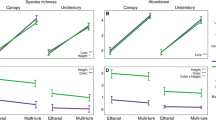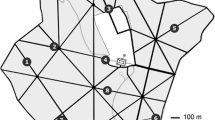Abstract
The study of insects inhabiting basal hollow trees presents a methodological challenge inducing the fact that there is very little research done on fauna of this habitat. Many endangered saproxylic species only develop in cavities located at ground level. One of the most emblematic species of the kind is the Violet Click Beetle (Limoniscus violaceus), included in Annex II of the UE “Habitats” Directive. Surveys have been conducted in five Natura 2000 areas using a new method to monitor L. violaceus: the emergence traps. A total of 376 beetle species, including 239 saproxylics, have been identified. Five are considered threatened and are registered on the European Red List of saproxylic beetles and three are included in Annex II of the “Habitats” Directive. Among 191 trees studied, 33 revealed the presence of L. violaceus. Sampling efforts required to detect at least one specimen have been evaluated. Our results show that sampling a minimum of 20 hollow trees in April and May with emergence traps is recommended to obtain a meaningful survey on the presence of the Violet Click Beetle.





Similar content being viewed by others
References
Agresti A, Coull BA (1998) Approximate is better than “exact” for interval estimation of binomial proportions. Am Stat 52:119–126
Allen AA (1937) Limoniscus violaceus Müll. (Elateridae), a genus and species of Coleoptera new to Britain. Entomol Rec J Var 49:110–111
Bedel L (1906) Captures de coléoptères dans la forêt de Compiègne. Bull Soc Entomol Fr 1906:215–216
Bouget C, Brustel H, Brin A, Noblecourt T (2008a) Sampling saproxylic beetles with window flight traps: methodological insights. Rev Ecol Terre Vie Suppl 10:21–32
Bouget C, Brustel H, Zagatti P (2008b) The French information system on saproxylic beetle ecology (Frisbee): an ecological and taxonomical database to help with the assessment of forest conservation status. Rev Ecol Terre Vie Suppl 10:33–36
Bouget C, Brustel H, Brin A, Valladares L (2009) Evaluation of window flight traps for effectiveness at monitoring dead wood-associated beetles: the effect of ethanol lure under contrasting environmental conditions. Agric For Entomol 11:143–152
Brustel H, Clary J (2000) Oh, cette Grésigne! Acquisitions remarquables pour cette forêt et le Sud-Ouest de la France: données faunistiques et perspectives de conservation; supplément au catalogue de Jean Rabil, 1992, 1995 (Coleoptera). Bull Soc Entomol Fr 105:357–374
Brustel H, Valladares L, Van Meer C (2004) Contribution à la connaissance de Coléoptères saproxyliques remarquables des Pyrénées et des régions voisines. Bull Soc Entomol Fr 109:413–424
Bußler H, Müller J (2009) Vacuum cleaning for conservationists: a new method for inventory of Osmoderma eremita (Scop., 1763) (Coleoptera: Scarabaeidae) and other inhabitants of hollow trees in Natura 2000 areas. J Insect Conserv 13:355–359
Chapman AJ, Kinghorn JM (1955) Window flight traps for insects. Can Entomol 37:46–47
Colas G (1974) Guide de l’entomologiste. L’entomologiste sur le terrain; préparation et conservation des insectes et des collections. Boubée N. & Cie, Paris
Condrillier, G. (1940) Sur la capture de Limoniscus violaceus Müll. à la Sainte-Baume (Var.) (Col. Elateridae). Ann Soc Hist Nat Toulon 23:77
Council of the European Community (1992) Directive 92/43 on the conservation of habitats and of wild fauna and flora. European Community, Brussels
Crawley MJ (2005) Statistics, an introduction using R. Wiley, Chichester
Delpy D, Burle F (1992) Contribution à la connaissance des Coléoptères du Lot et des causses du Quercy. III. Elateridae. L’entomologiste 48:93–98
Dubois G (2009) Ecologie des coléoptères saproxyliques : Biologie des populations et conservation d’Osmoderma eremita (Coleoptera: Cetoniidae). Phd thesis, Université de Rennes 1, Rennes
Gouix N (2011). Gestion forestière et Biodiversité, les enjeux de conservation d’une espèce parapluie: Limoniscus violaceus (Coleoptera). Phd thesis, Université Pierre et Marie Curie, Ecole Doctorale de la Diversité du Vivant, Paris
Gouix N, Zagatti P, Brustel H (2009) Emergence of beetles from hollow trees–habitat requirements for Limoniscus violaceus (PWJ Muller, 1821) (Elateridae). In: Buse J, Alexander KNA, Ranius T, Assmann T (eds) Saproxylic beetles: their role and diversity in European woodland and tree habitats–Proceedings of the 5th symposium and workshop (Lüneburg, 2008). Pensoft Ser Faun 89:133–148
Harrell FE (2010) Hmisc: Harrell miscellaneous. R package version 3.8. http://cran.r-project.org/web/packages/Hmisc/index.html
Hedin J, Ranius T, Nilsson SG, Smith HG (2008) Restricted dispersal in a flying beetle assessed by telemetry. Biodivers Conserv 17:675–684
Husler F, Husler J (1940) Studien über die Biologie der Elateriden (Schnellkäfer). Mitt Münch Entomol Ges 30:343–397
Iablokoff AK (1943) Ethologie de quelques élaterides du massif de Fontainebleau. Mem Mus Nat Hist Nat 18:83–160
Jansson N (2009) Habitat requirements and preservation of the beetle assemblages associated with hollow oaks. Phd thesis, Linköping University, Linköping
Jönsson N, Méndez M, Ranius T (2004) Nutrient richness of wood mould in tree hollows with the Scarabaeid beetle Osmoderma eremita. Anim Biodivers Conserv 27:79–82
Köhler F. (2001) Veilchenblauer Wurzelhalsschnellkäfer (Limoniscus violaceus). In Fartman et al (eds) Berichtspflichten in Natura-2000-Gebieten. Empfehlungen zur Erfassung der Arten des Anhangs II und Charakterisierung der Lebensraumtypen des Anhangs I der FFH-Richtlinie. Angewandte Landschaftsökologie (Bonn) 42:298-301
Larsson MC, Svensson GP (2009) Pheromone monitoring of rare and threatened insects: exploiting a pheromone–kairomone system to estimate prey and predator abundance. Cons Biol 23:1516–1525
McArdle BH (1990) When are rare species not there. Oikos 57:276–277
Mendel H, Owen JA (1990) Limoniscus violaceus (Muller) (Col.: Elateridae), the violet click beetle in Britain. Entomologist 109:43–46
Mequignon A (1930) Coléoptères de Touraine: contribution à la faune du département d’Indre- et-Loire et des départements voisins. Ann Soc Entomol de Fr 85:19–36
Merkl O, Mertlik J (2005) Distributional notes and a checklist of click beetles (Coleoptera: Elateridae) from Hungary. Folia Entomol Hung 66:63–80
Mertlik J (2007) Result of search for click-beetles Zorochos kourili (Roubal, 1936) (Coleoptera: Elateridae). Elateridarium 1:56–65
Mertlik J, Dušánek V (2006) Description of five new species of click-beetles (Coleoptera, Elateridae) from the Palaearctic region with remarks about the distributions 22 additional species. Folia Heyrovskyana 13:145–162
Mertlik J, Platia G (2008) Catalogue of the family Cebrionidae, Elateridae, Lissomidae, Malsidae and Throscidae (Coleoptera) from Turkey. Elateridarium 2:1–40
Mertlik J, Samek H (2009) First record of four click-beetles (Coleoptera: Elateridae) from Ukraine. Elateridium 3:30–34
Micó E, Marcos-García A, Quinto J, Ramírez A, Ríos S, Padilla A, Galante E (2010) Los árboles añosos de las dehesas ibéricas, un importante reservorio de insectos saproxylícos amenazados. Elytron 24:1–9
Müller J, Bußler H, Bense U, Brustel H, Flechtner G, Fowles A, Kahlen M, Möller G, Mühle H, Scmidl J, Zabransky P (2005) Urwald relict species–Saproxylic beetles indicating structural qualities and habitat tradition. Waldoekologie Online 2:106–113
Müller J, Hothorn T, Pretzsch H (2007) Long-term effects of logging intensity on structures, birds, saproxylic beetles and wood-inhabiting fungi in stands of European beech Fagus sylvatica L. For Ecol Manage 242:297–305
Murria F, Murria A (2004) Presencia de Limoniscus violaceus (Muller, 1821) en Aragon (Espana) (Coleoptera, Elateridae). Bol SEA 35:293
Németh O, Merkl O (2009) Rare saproxylic click beetles in Hungary. Distributional records and notes on life history (Coleoptera: Elateridae). Folia Entomol Hung 70:97–137
Nieto A, Alexander KNA (2010) European Red List of saproxylic beetles. Publications Office of the European Union, Luxembourg
Oleksa A, Ulrich W, Gawronski R (2006) Occurrence of the marbled rose-chafer (Protaetia lugubris Herbst, Coleoptera, Cetoniidae) in rural avenues in northern Poland. J Insect Conserv 10:241–247
R Development Core Team (2009) R: a language and environment for statistical computing. R Foundation for statistical computing, Vienna, Austria. http://www.R-project.org
Ranius T (2001) Constancy and asynchrony of Osmoderma eremita populations in tree hollows. Oecologia 126:208–215
Ranius T (2002) Population ecology and conservation of beetles and pseudoscorpions living in hollow oaks in Sweden. Anim Biodivers Conserv 25:53–68
Ranius T, Hedin J (2001) The dispersal rate of a beetle, Osmoderma eremita, living in tree hollows. Oecologia 126:363–370
Ranius T, Jansson N (2002) A comparison of three methods to survey saproxylic beetles in hollow oaks. Biodivers Conserv 11:1759–1771
Recalde JI, Sánchez-Ruiz A (2002) Elateridae (Coleoptera) forestales de Navarra (II). Recaptura de Limoniscus violaceus (Müller, 1821) en la Península Ibérica, y comentarios sobre su distribución, biología y “status”. Bol SEA 30:161–163
Růžička J, Jansson N, Coskun M (2006) Complementary description of Catops hanusi (Coleoptera: Leiodidae: Cholevinae), with notes on its bionomy and occurrence in Turkey. Entomol Prob 36:43–46
Serres E, Blanc M (2010) Nouvelles données sur la biologie et la répartition de Limoniscus violaceus (P.W. J. Müller, 1821) (Coleoptera, Elateridae). Rutilans 13:16–19
Svensson GP, Larsson MC, Hedin J (2004) Attraction of the larval predator Elater ferrugineus to the sex pheromone of its prey, Osmoderma eremita, and its implication for conservation biology. J Chem Ecol 30:353–363
Sverdrup-Thygeson A, Skarpaas O, Odegaard F (2010) Hollow oaks and beetle conservation: the significance of the surroundings. Biodivers Conserv 19:837–852
Whitehead PF (2003) Current knowledge of the Violet Click Beetle Limoniscus violaceus (P. W. J. Müller. 1821) (Col., Elateridae) in Britain. In: Bowen C (ed) Proceedings of the second pan-European conference on saproxylic beetles. Peoples’ trust for endangered species. University of London, Royal Holloway
Wilson EB (1927) Probable inference, the law of succession, and statistical inference. J Am Stat Assoc 22:209–212
Wintle BA, Kavanagh RP, McCarthy MA, Burgman MA (2005) Estimating and dealing with detectability in occupancy surveys for forest owls and arboreal marsupials. J Wild Manage 69:905–917
Zach P (2003) The occurrence and conservation status of Limoniscus violaceus and Ampedus quadrisignatus (Coleoptera, Elateridae) in Central Slovakia. In: Bowen C (ed) Proceedings of the second pan-European conference on saproxylic beetles. Peoples’ Trust for Endangered Species. University of London, Royal Holloway
Acknowledgments
We thank S. Danflous and A. Guy for reviewing language. For identification of specimens we thank R. Allemand (Byrrhidae, Ptinidae), P. Berger (Elateridae), C. Bouget (Monotomidae), A. Brin (Carabidae), L. Chekir (Latridiidae, Corylophilydae, Scydmaenidae), J. P. Coutanceau (Coccinelidae), E. Dupré (Leiodidae), E. de Laclos (Anobiidae), P. Leblanc (Anaspidae-Scraptidae), G. Liberti (Cantharidae, Malachidae, Melyridae), T. Noblecourt (Scolytidae), O. Rose (Ciidae), F. Soldati (Tenebrionidae), M. Tronquet (Staphylinidae) L. Valladares (Curculionidae). We are grateful to L. Valladares, G. Parmain, C. Salvan, A. Bogetto, R. Minetti, J. H. Yvineck, C. Vacquié, B. Meriguet, P. Zagatti for assistance in the field. This study was supported by the National Forest Office, the ANRT and the European Commission.
Author information
Authors and Affiliations
Corresponding author
Rights and permissions
About this article
Cite this article
Gouix, N., Brustel, H. Emergence trap, a new method to survey Limoniscus violaceus (Coleoptera: Elateridae) from hollow trees. Biodivers Conserv 21, 421–436 (2012). https://doi.org/10.1007/s10531-011-0190-1
Received:
Accepted:
Published:
Issue Date:
DOI: https://doi.org/10.1007/s10531-011-0190-1




